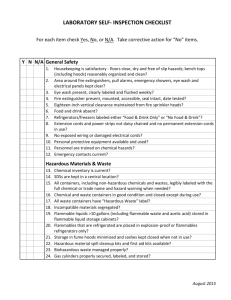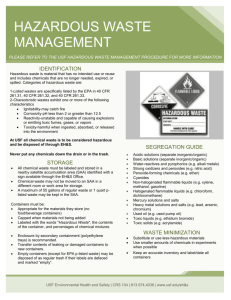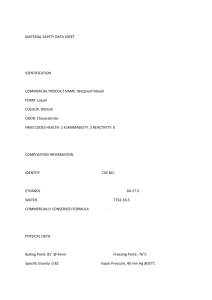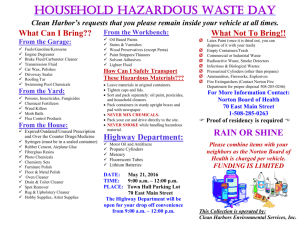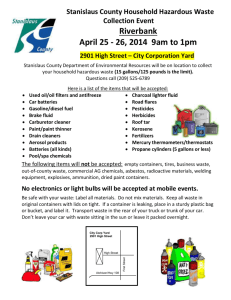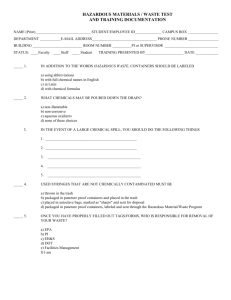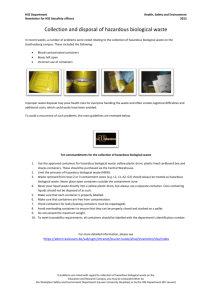UCSC Laboratory Self Inspection Form
advertisement
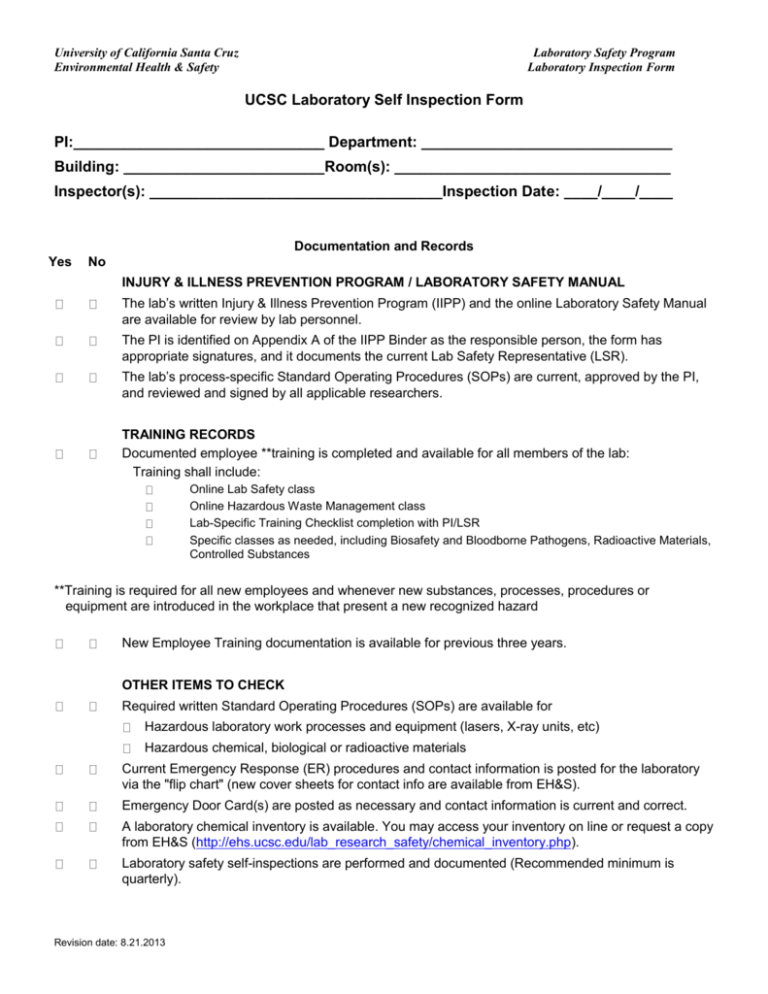
University of California Santa Cruz Environmental Health & Safety Laboratory Safety Program Laboratory Inspection Form UCSC Laboratory Self Inspection Form PI:______________________________ Department: ______________________________ Building: ________________________Room(s): _________________________________ Inspector(s): ___________________________________Inspection Date: ____/____/____ Documentation and Records Yes No INJURY & ILLNESS PREVENTION PROGRAM / LABORATORY SAFETY MANUAL The lab’s written Injury & Illness Prevention Program (IIPP) and the online Laboratory Safety Manual are available for review by lab personnel. The PI is identified on Appendix A of the IIPP Binder as the responsible person, the form has appropriate signatures, and it documents the current Lab Safety Representative (LSR). The lab’s process-specific Standard Operating Procedures (SOPs) are current, approved by the PI, and reviewed and signed by all applicable researchers. TRAINING RECORDS Documented employee **training is completed and available for all members of the lab: Training shall include: Online Lab Safety class Online Hazardous Waste Management class Lab-Specific Training Checklist completion with PI/LSR Specific classes as needed, including Biosafety and Bloodborne Pathogens, Radioactive Materials, Controlled Substances **Training is required for all new employees and whenever new substances, processes, procedures or equipment are introduced in the workplace that present a new recognized hazard New Employee Training documentation is available for previous three years. OTHER ITEMS TO CHECK Required written Standard Operating Procedures (SOPs) are available for Hazardous laboratory work processes and equipment (lasers, X-ray units, etc) Hazardous chemical, biological or radioactive materials Current Emergency Response (ER) procedures and contact information is posted for the laboratory via the "flip chart" (new cover sheets for contact info are available from EH&S). Emergency Door Card(s) are posted as necessary and contact information is current and correct. A laboratory chemical inventory is available. You may access your inventory on line or request a copy from EH&S (http://ehs.ucsc.edu/lab_research_safety/chemical_inventory.php). Laboratory safety self-inspections are performed and documented (Recommended minimum is quarterly). Revision date: 8.21.2013 Laboratory Practices, Equipment & Facilities Yes No Is good housekeeping practiced in the work area? Is it free of debris, combustibles, excessive storage and obstructions? Are spills promptly cleaned up? Are food and beverages prepared and consumed away from lab workspaces and stored out of chemical storage refrigerators and cabinets? Is proper Personal Protective Equipment (PPE) readily available for all personnel, including visitors, and worn when working in the lab? (Safety glasses or goggles, appropriate gloves, lab coat, apron, face shield, etc. NO SHORTS OR SANDALS) Are eye wash/safety showers available in areas where corrosives and toxics are used? Blocked Not Apparent Needed but not available Do lab personnel know the location and how to operate the safety shower/eye-wash and is it accessible (not blocked)? Do lab personnel have access and understand how to use Material Safety Data Sheets (MSDSs)? (Access database at: www.ucmsds.com) Is the fume hood sash at a proper operating level and is a quantitative flow device (magnehelic gauge, visual indicators w/ red & green warning lights, low flow alarm, etc) present to verify the hood is drawing air properly? Is storage of chemicals and equipment kept to a minimum in the fume hood so airflow is not impeded or excessive turbulence generated? Are all of the lab facilities in good repair, including light fixtures, plumbing and ceiling tiles? Comments: _____________________________________________________________________ Are microwave ovens, refrigerators and freezers properly labeled based on storage classification (NON-FLAM CHEM ONLY, FOOD ONLY, etc.)? Hazardous Materials Storage & Labeling Do chemical containers have legible, current labels to identify contents and hazards of the material? Are chemicals segregated according to hazard class and compatibility (oxidizing from organic acids, bases, flammables, etc.), into appropriate storage cabinets (corrosives, flammables) or labeled secondary containment trays? Are peroxide forming chemicals (ethyl ether, tetrahydrofuran, dioxane) managed in the lab (date of purchase, date opened, disposed when expired)? Are flammable liquids used / stored away from sources of heat and ignition? Are approved, spark-proof, lab-safe refrigerators and freezers used for storage of flammable liquids that require them? Are all excess flammable liquids (dispensing reagent containers and aggregate > 10 gal.), including wastes, kept in approved flammable liquid storage rooms or cabinets? Do flammable liquid cabinet doors close and latch properly? Are corrosives, flammables, skin-absorbable poisons and heavy equipment kept below eye level? Comments: Revision date: 8.21.2013 Page 2 of 4 Date: ___________ Hazardous Materials Storage & Labeling (continued) Yes No Are all flammable liquid cabinets located away from evacuation routes; heat or ignition sources and combustible materials storage (i.e., no paper stored on or around cabinet)? Are all gas cylinders properly secured with 2 metal straps or chains (top 1/3, bottom 1/3) or other adequately engineered system to prevent tipping or falling? Are fuel gas cylinders and oxygen cylinders separated by distance and fire-resistant barriers, while in storage? Are cylinder valves shut off, gauges removed and valve caps in place when not required for ongoing experiments? Are cylinder contents labeled and labels easily seen? Are flammables, corrosives and skin-absorbable poisons kept off the floor in common practice and secondarily contained if temporary placement on the floor is necessary? Are glass and sharps (needles, syringes, razor blades, etc.) stored in approved puncture resistant containers and properly labeled (biohazardous sharps, sharps, etc.)? Are secondary containment trays clean and free of visible contamination? Hazardous Waste Storage & Disposal Are hazardous materials disposed of properly, rather than by sewer, evaporation or ordinary trash, (including containers with any remaining chemicals)? Are all waste containers w/ liquid in secondary containment? Is the containment free of spills and contamination? Is the storage location visible or identified to EH&S? Is the size of the container appropriate for the rate of waste accumulation? Are incompatibles segregated (e.g. acids and bases in separate trays)? Are all containers sealed with the proper fitting lids/caps at all times except when adding hazardous waste? Are container tops and sides free of spillage or visible contamination? Are the containers no more than 80% full? Are all containers, lids and caps compatible with hazardous waste (e.g., strong acids or bases stored in glass containers as opposed to plastic.)? Are all hazardous waste containers stored in a safe location (e.g. not in high traffic areas, away from any heat source)? Are all hazardous waste containers disposed of within 6 months of accumulation start date and/or are all full containers listed on a chemical waste pickup form to be submitted to EH&S? Are Extremely Hazardous Wastes properly identified and kept in quantities of < 1 quart? Are all full containers disposed of within three days? (List of Extremely Hazardous Wastes at: http://ehs.ucsc.edu/Waste_Management/ehs.asp?page=pubs/Determination_Guide/b51) Hazardous Waste Labeling Do all hazardous waste containers have an EH&S Hazardous Waste Tag attached before waste is added to the container? Are all chemical ingredients listed as part of the waste composition? Are chemical names and not formulas used? Revision date: 8.21.2013 Page 3 of 4 Date: ___________ Fire and Electrical Safety Yes No Are fire doors unobstructed and closed during work? Are fire extinguishers mounted, clearly visible and fully charged? Is emergency equipment (alarm pull boxes, fire alarms, etc.) accessible and not blocked? Are supplies and equipment stored at least 18 inches from fire detection and suppression devices? Are electrical boxes, panels, receptacles, and fittings properly covered to prevent shock? Are the electrical appliances and lab equipment in good repair or removed from service? Are electrical extension cords used only for temporary operations, UL listed, equipped with a 3-prong plug, kept out of walkways and run directly to outlet (no daisy chain)? Are all multiple-outlet surge suppressers/power strips approved, UL-listed and used only for computers, peripherals and small equipment (not to power high wattage equipment)? Are electrical outlets within 6 feet of a water source or "wet area" equipped with a GFCI-type outlet (consider water baths, aquariums, & other operations with electrocution risk)? Are electrical cords free from damage, fraying, tape, or cracking; grounded with 3-prong plugs and not run through walls, ceilings, doors, across walkways or under equipment? Is there at least a 30-inch clearance in front of electrical panels/breaker boxes? Are hot plates, temp-blocks and other temporary heating units unplugged when not in use? Illumination and Egress Are exit signs visible and illuminated? Are exit aisles clear and free of obstructions (44", 36" or 24" clearance as required)? Are the windows, doors and automatic door closing devices in good repair? Seismic Safety Are shelves and equipment greater than 4 ft. tall seismically braced to prevent falling? Do shelves and cabinet tops have lips or bungee restraints to prevent items from falling? Are shelf tops > 5 feet high without bungee or other restraints free of storage? Comments: Revision date: 8.21.2013 Page 4 of 4 Date: ___________

